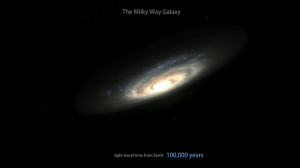SETI Institute Anniversary 1/6: The Milky Way Galaxy
Foggy day & Foggy mind – SETI Anniversary Colloquium
February 18, 2010SETI Institute Anniversary 2/6: Its Majesty Mars: the Red Planet
February 23, 2010It is getting more and more difficult to find a dark place, without night pollution and far from the smog of the cities, to be able to realize that we are part of a large barred spiral galaxy called the “Milky Way Galaxy”. Seen from Earth, our galaxy will appear as a fuzzy arc in the sky commonly called the Milky Way and composed of 200-400 billion stars. This picture taken by Tony Hallas, a mosaic of 24 frames taken in north of California, was shown in APOD on December 25 2009.
Our Galaxy is old with an estimated age of 13.2 billion years, almost as old as the universe. It is a large barred spiral galaxy with a diameter of 100,000 light-years. Even if it is not as big as Andromeda (1,000 billion stars), our Sun is one star among 200 to 400 billion of them. Our Solar system orbits around the center of the spiral galaxy at 25,000 light-years in 200 million years.
If you inspect this image in detail (zooming into it) you will be able to see the large amount of stars in our galaxy. Each star has a different color which is due to its size, temperature, and age, but also its environment.
Among these stars, 10% of them are similar to our Sun (20-40 billion G-type star with the same Temperature, size and Mass), and could have terrestrial planets like Earth. Astronomers have been working on catalogs of stars over 2 centuries. These catalogs contain their positions in the sky and their properties (size, mass, age, metallicity). It is only recently that astronomers tried to find stars with exoplanets and listed those which could have an habitable planets. Because there is a large amount of stars in our galaxy, this is definitely of tedious work. Several researchers at the SETI Institute have been involved in these projects for years. Their goal is to provide a detailed map of our Milky Way Galaxy containing the characteristics of these stars and their planets. These maps could be used by the future generations to explore these unknown worlds when the technology will be available.
Next time you go outdoor and you can enjoy the magnificent view of the Milky Way, you may imagine one of these worlds. I bet that over there someone is looking at you and may be doing the same.
Enjoy the sky
Franck M.





2 Comments
Awesome Franck! thanks for the info…so when u say 20-40 billion similar to ours what exactly are you referring to? size, type, composition or all of the above..i remember u mentioned something about gold particles.
The metallicity is also an important parameters to form terrestrial planets. It has been shown that the higher the metallicity of stars the most likely they will have an exoplanet. I did not take that into account in my post (lack of time). To summarize the Sun is a metal rich star since it is part of the galaxy disk and close to its center (1/3). Most of the stars are in the disk of our galaxy and there are more starts in the center part of our galaxy, so the number of stars similar to our sun even considering the metallicity remains high.